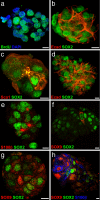SOX2-expressing progenitor cells generate all of the major cell types in the adult mouse pituitary gland
- PMID: 18287078
- PMCID: PMC2268558
- DOI: 10.1073/pnas.0707886105
SOX2-expressing progenitor cells generate all of the major cell types in the adult mouse pituitary gland
Abstract
The pituitary gland adapts the proportion of each of its endocrine cell types to meet differing hormonal demands throughout life. There is circumstantial evidence that multipotent adult progenitor cells contribute to this plasticity, but these cells have not been identified. Here, we describe a small (<0.05%) population of progenitor cells in the adult pituitary gland. We show that these cells express SOX2, a marker of several early embryonic progenitor and stem cell types, and form "pituispheres" in culture, which can grow, form secondary spheres, and differentiate to all of the pituitary endocrine cell types, as well as folliculostellate cells. Differentiation of cells in the pituispheres was associated with the expression of nestin, SOX9, and S100. Cells expressing SOX2 and E-cadherin are found throughout Rathke's pouch (RP) in embryos but persist in the adult gland, mostly in a narrow zone lining the pituitary cleft, but also are scattered throughout the pituitary. However, unlike in embryonic RP, most of these SOX2(+) cells in the adult gland also express SOX9 and S100. We suggest that this SOX2(+)/SOX9(+) population represents transit-amplifying cells, whereas the SOX2(+)/SOX9(-) cells we identify are multipotent progenitor/stem cells persisting in the adult pituitary.
Conflict of interest statement
The authors declare no conflict of interest.
Figures




References
-
- Moore KA, Lemischka IR. Science. 2006;311:1880–1885. - PubMed
-
- Gage FH. Science. 2000;287:1433–1438. - PubMed
-
- Leri A, Kajstura J, Anversa P. Physiol Rev. 2005;85:1373–1416. - PubMed
-
- Nolan LA, Kavanagh E, Lightman SL, Levy A. J Neuroendocrinol. 1998;10:207–215. - PubMed
-
- Levy A. J Endocrinol. 2002;174:147–155. - PubMed
Publication types
MeSH terms
Substances
Grants and funding
LinkOut - more resources
Full Text Sources
Other Literature Sources
Medical
Molecular Biology Databases
Research Materials

